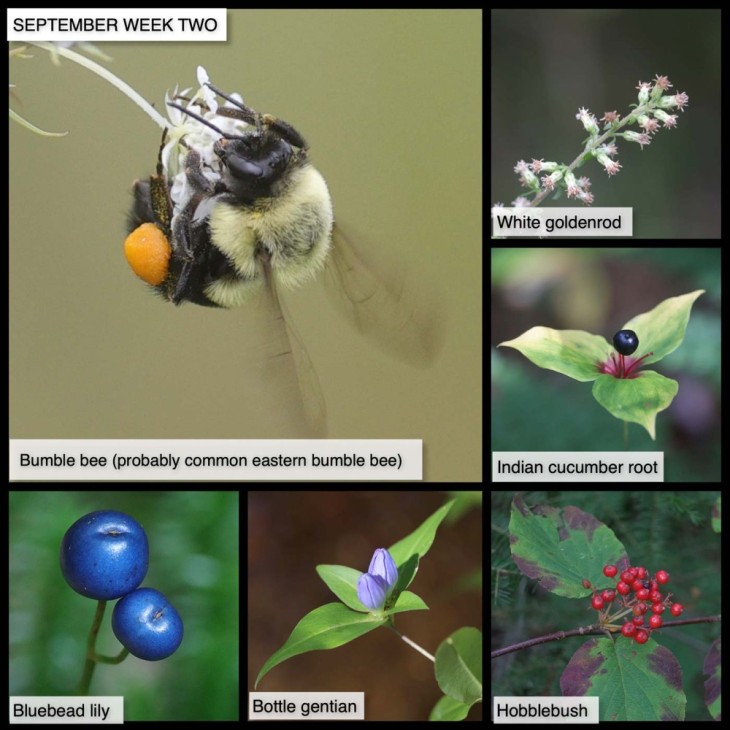This Week in the Woods, we’ve been paying closer attention to bumblebees. Like most other pollinators, they’re winding down their year as the weather cools. Unlike honeybee hives, which can overwinter multiple years, bumblebee hives start anew each spring with a young queen’s emergence from the ground. The hive dies off in autumn as the queen stops producing new worker bees. By that time, if all goes well, a crop of young queens have successfully mated and burrowed into the ground to hibernate for the winter. To learn more about challenges to bee populations and how to help them, see this page from Vermont Fish and Wildlife, which offers links to multiple resources. For anyone wanting to take a deep dive into the subject of bumblebees (what are cuckoo bees, and how do “smelly feet” help one bee know what flowers have already been visited?), check out the book A Sting in the Tale by Dave Goulson, founder of the U.K.’s Bumblebee Conservation Trust. See also this article from the Autumn 2021 issue of Northern Woodlands magazine, describing efforts to promote native pollinator-friendly plants in Connecticut.
Here are some other nature sights this week (clockwise):
Of the 25 goldenrod species growing in our region, white goldenrod, also called silverrod, is the only one with white ray flowers (what look like petals). Like other goldenrods, this spiky weed of fields and wood edges provides valuable late-season food for pollinators, and a close inspection of its blooms reveals all kinds of tiny insects. Here’s a profile of white goldenrod from The Native Plant Trust, and here’s an Outside Story article about goldenrods by Joe Rankin.
This is a great time to see berries in the woods – although not, as a general rule, to eat them! Among the most eye-catching of these are the dark blue berries of Indian cucumber-root, a member of the lily family, which displays its berries in a whorl of yellowing leaves that has a splash of crimson in the center. We’ve written about the plant before; here’s a post from July 2020, showing Indian cucumber root’s odd flowers with purple-red pronged stigmata.
Hobblebush is also already showing fall color. Look for clusters of bright red berries and green leaves spotted with darker colors, especially purple. As Tom Slayton notes in this Outside Story article, although this woodland shrub has its detractors (for example, hunters and hikers who try to walk through its thickets), it’s a great pollinator plant, and it’s especially beautiful both in late spring, when it blossoms, and at this time of year.
She’s done it again! We took this photo of a bottle gentian blooming along a stream, only to realize that Mary Holland had taken a much more dazzling image of a bumblebee pollinating a bloom. As Holland notes, the petals of these flowers (four similar looking species in New England) remain closed, and bumblebees are some of the few insects with the strength to pry them apart. Although this is energetically costly for the bees, the plant compensates them by providing especially nutritious pollen and nectar.
Bluebead lily, also called by its genus name, Clintonia, typically grows in moist forest soil, and you can sometimes find it in large patches along wooded streams. This wildflower’s greenish yellow bloom is easy to miss in late spring, when there are so many other, brighter flowers on display. Its large blue berries are much more eye-catching, especially when you stumble on a group of them. Here’s a profile from Adirondacks Forever Wild.
Our thanks to The Bailey Charitable Foundation and the Frank and Brinna Sands Foundation for helping to support this series.
In this difficult period, many of us find joy in observing local nature. This series, launched in April 2020, shares nature photographs taken in the past seven days, or in the same week in 2020, most within 15 miles of the Northern Woodlands office in Lyme, New Hampshire. We hope you enjoy using this grid as a prompt for your own explorations.
What are you seeing in the woods this week? Share your images with us on Facebook, or submit a special photo for possible inclusion in our monthly online Reader Photo Gallery.



Discussion *